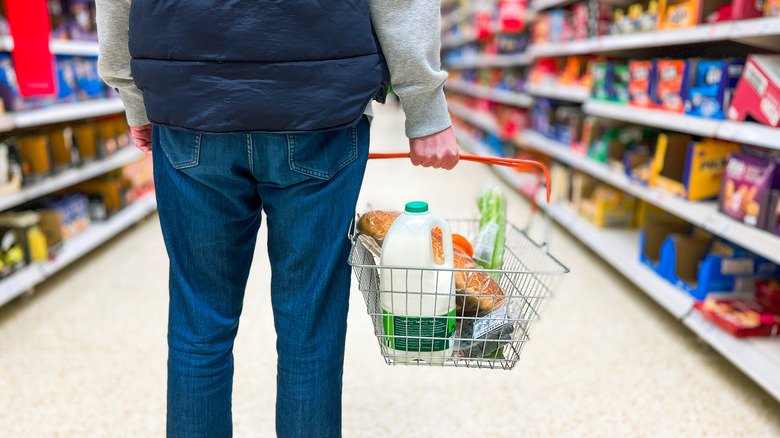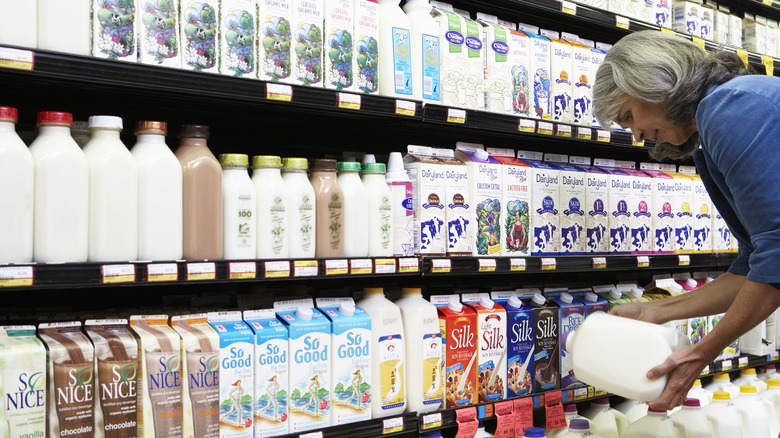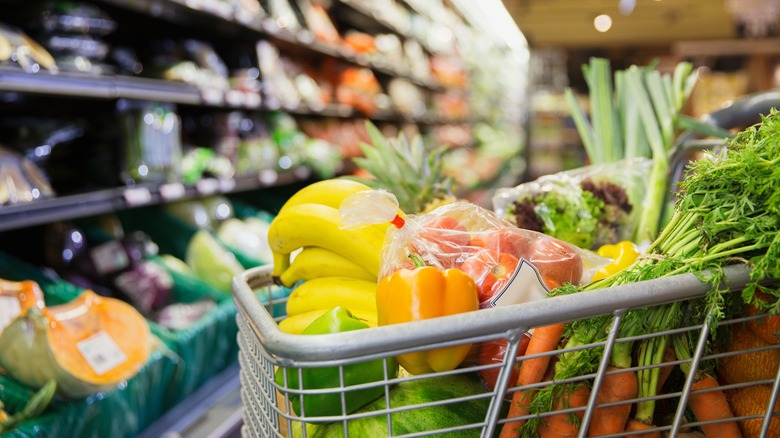The Reason Your Grocery Store's Dairy Aisle Is In The Back Left Corner
For many people, the grocery store is a dreadful destination. Whether you prepare a lengthy list or only need one thing, navigating the chaos of crowded aisles often feels unnecessarily difficult, let alone time-consuming. Why do you have to walk through the entire store just to grab milk or bread, anyway?
Regardless of where you buy groceries, chances are the dairy section is tucked away in the back of the store. Trying to make a beeline for the dairy section to get in and out in only a few minutes feels impossible. No matter what, your route will take you through the thick of things. Do you weave through the bakery and deli or the freezers packed full of convenient foods? When was the last time you had a cupcake? A sweet treat after a long day sounds nice. And a frozen pizza might help with the "hangry" feeling, too. Before you know it, your grocery basket is full, and you've spent more money than you meant to. At least you didn't forget what you came for — hopefully.
If you walk out of the store feeling disoriented, maybe even paranoid that you're in the midst of a conspiracy to leave with things you didn't need, you're not wrong. The layout of a grocery store (and the location of its most popular items, including dairy) is designed to make you shop more. A little awareness of how can go a long way in empowering your decisions over what you buy.
Buying the essentials, and everything else
You've probably noticed that you take a similar route through the grocery store each time. It's often a loop, that the store itself gently encourages shoppers to follow by placing essential items — produce, bread, meat, and dairy — in specific locations.
Psychologist Paco Underhill told Bon Appétit that the layout of supermarkets has remained roughly the same for decades. He said, "The basic layout hasn't changed much in almost 80 years: I walk in, produce tends to be upfront and to the right, meat and seafood tend to be back and to the right, dairy is generally in the back left-hand corner — the deepest section of the store."
Placing dairy in the back (and far away from other essentials like bread) means shoppers will spend more time inside the store. As shoppers walk around more to pick up what they need, there are more opportunities for customers to wander the aisles or pass by displays, picking up stuff that they don't.
However, not everyone thinks the location of the dairy aisle is to trick people into filling up their carts. Since dairy needs to be kept cold, economist Russell Roberts proposes that stores place dairy coolers in the back to make stocking efficient, prevent spoilage, and cut costs. Of course, both explanations for why milk is where it is can be true at the same time. Would it be surprising that grocery stores come up with strategies to save money while also making more of it? After all, the dairy aisle's location is just one of many ways stores entice customers to buy more.
The planning behind your grocery store experience
When it comes to being a customer, little is left to accident. Whether you're at Whole Foods or Aldi, a lot of market research and psychology goes into how you buy food. Much like the thousands of products within its walls, the layout of a grocery store is itself a product of thoughtful planning. From the location of aisles to which products are paired with other products, many of these decisions are designed to increase the amount of time that customers spend in the store.
How your senses are engaged while shopping is intentional, too. This could be something as simple as free samples and the music that plays in the grocery store or as sly as the placement of brightly colored, cartoon-clad cereal boxes on lower shelves where children can easily see them. Even the increasing size of grocery carts is connected to how much we buy. As they get larger, shoppers are inclined to spend more.
So, how can you resist the temptatious tactics of the grocery store? Write and stick to a grocery list. Use your arms or a basket instead of a cart. Listen to your own music or a podcast. Ignore the smell of freshly baked cookies wafting from the bakery — and don't shop hungry. Be mindful of how much your cart costs as you add items to it. Order your groceries for delivery or pickup to avoid the store altogether. And if you're only there for milk, grab it and go.


